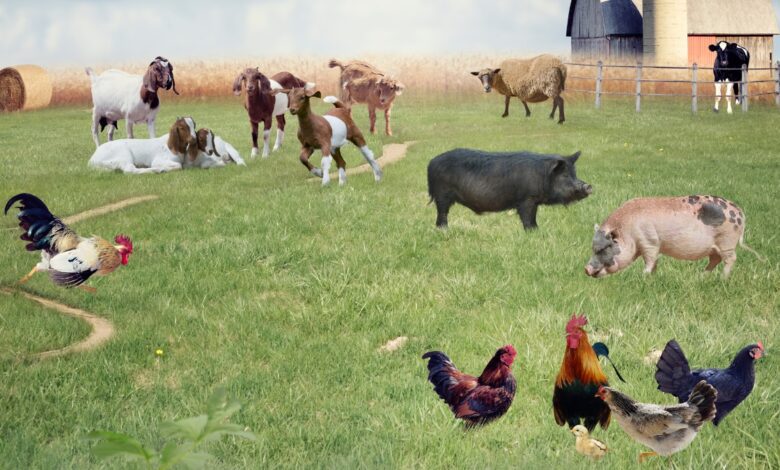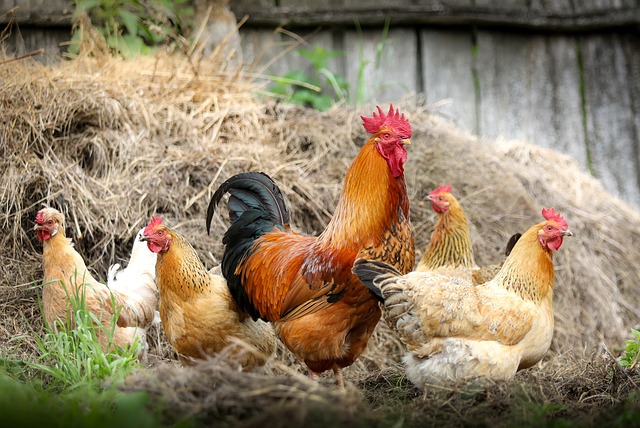Farm Animals: Types, Facts, and Pictures

Farm animals are an essential part of agriculture and play a crucial role in providing various resources like meat, milk, eggs, and wool. They are domesticated animals that have been selectively bred for specific purposes.
Table of Contents
What Are Farm Animals?
Farm animals, also known as livestock, are domesticated animals that are raised for various agricultural purposes. They are an integral part of farming and contribute to the production of food, fiber, labor, and other resources. Humans have been selectively breeding and raising farm animals for thousands of years, resulting in a diverse range of species and breeds suited to different farming systems and geographical regions.

Types of Farm Animals
• Cattle
Cattle, including cows and bulls, are one of the most common types of farm animals. They are primarily raised for meat (beef) and milk production. Cattle are large, herbivorous animals that graze on grass and other vegetation. They have a complex digestive system with four compartments in their stomach, allowing them to extract nutrients from plant-based diets efficiently.
• Poultry
Poultry refers to domesticated birds raised for their meat and eggs. Chickens are the most prevalent poultry animals, but other birds such as turkeys, ducks, and geese are also raised on farms. Chickens provide a significant source of eggs and meat worldwide. Poultry farming has become an essential sector in the agricultural industry due to the high demand for poultry products.
• Swine
Swine, commonly known as pigs, are farm animals raised for pork, bacon, and other pork products. Pigs are highly adaptable and can thrive in various environments. They have a remarkable sense of smell and are known for their intelligence. Pig farming, or hog farming, is practiced in many parts of the world and plays a significant role in meat production.
• Sheep
Sheep are farm animals primarily raised for their wool, meat (lamb and mutton), and milk. They are well-suited to grazing on grass and have been domesticated for thousands of years. Sheep provide valuable wool, which is used in textile manufacturing, and their meat is consumed in various cuisines worldwide. They are known for their distinctive appearance, with woolly coats and often curving horns.
• Goats
Goats are versatile farm animals that are raised for milk, meat, and fiber (cashmere, mohair). They are agile and adaptable, capable of thriving in diverse environments, including mountains, deserts, and grasslands. Goats are known for their browsing behavior, where they prefer to eat leaves, shrubs, and other vegetation. They are also skilled climbers and can navigate steep terrains.
• Horses
Horses have been domesticated for centuries and have played a crucial role in agriculture, transportation, and recreational activities. While horses are not typically raised for meat, they are used in farming operations, such as plowing fields and pulling carts. Horses are also beloved companions and are involved in various equestrian sports and recreational riding.
• Ducks
Ducks are farm animals that are raised for their meat, eggs, and feathers. They are waterfowl and have adapted to aquatic environments. Duck farming is practiced worldwide, particularly for meat production and egg-laying purposes. Ducks have oily feathers that provide excellent insulation and buoyancy in water.
• Bees
While not traditionally considered farm animals, bees play a vital role in agriculture through their pollination services. Honey bees, in particular, are kept in hives on farms to support the pollination of crops. They produce honey, beeswax, and other bee-related products. Beekeeping, also known as apiculture, is an essential practice for supporting crop yields and maintaining biodiversity.

Facts About Farm Animals
Let’s explore some interesting facts about farm animals:
• Cattle
Cows have an excellent sense of smell and can detect scents up to six miles away.
Cattle have a unique digestive system called rumination, where they regurgitate their food and chew it again to aid digestion.
• Poultry
Chickens are the closest living relatives of the Tyrannosaurus rex dinosaur.
A chicken’s ear can detect a wide range of sounds, including ultrasonic frequencies.
• Swine
Pigs are highly intelligent animals and can be trained to perform various tasks.
Pigs have a strong sense of smell and are often used in detecting truffles, a highly prized type of mushroom.
• Sheep
Sheep have a field of vision of around 300 degrees, allowing them to have excellent peripheral vision.
Sheep have a unique behavior called flocking, where they tend to stay close together for safety and social interaction.
• Goats
Goats are known for their agility and climbing abilities, thanks to their hooves and muscular bodies.
Goats are browsers, meaning they prefer to eat leaves, twigs, and other vegetation rather than graze on grass.
• Horses
Horses have the largest eyes of any land mammal.
Horses communicate through a variety of vocalizations, body language, and facial expressions.
• Ducks
Ducks have a specialized gland, called the preen gland, which produces oil to make their feathers waterproof.
Ducks are excellent swimmers and have webbed feet for efficient movement in the water.
• Bees
Bees are incredible pollinators and are responsible for pollinating a significant portion of flowering plants.
Honey bees communicate through a unique dance language known as the “waggle dance” to convey the location of food sources to other bees.
Conclusion
Farm animals are diverse and fascinating creatures that play a vital role in agriculture and food production. From cattle and poultry to swine and sheep, each type of farm animal offers unique contributions and resources. By understanding their characteristics and significance, we can appreciate the valuable roles they play in sustaining human societies.

FAQs
• What are some considerations for raising farm animals?
Raising farm animals requires careful consideration of their housing, nutrition, healthcare, and welfare needs. Adequate space, proper nutrition, access to clean water, veterinary care, and protection from predators and extreme weather conditions are essential factors to consider.
• How do farm animals contribute to sustainable agriculture?
Farm animals contribute to sustainable agriculture by providing renewable resources like meat, milk, eggs, and wool. They also play a role in nutrient cycling, soil fertility, and pest control on farms. Additionally, integrated farming systems that combine crops and livestock help optimize resource utilization and minimize environmental impacts.
• Can farm animals be kept as pets?
While farm animals are primarily raised for agricultural purposes, some individuals keep them as pets. However, it’s important to consider their specific needs, space requirements, and legal regulations before keeping farm animals as pets.
• How are farm animals cared for on modern farms?
Modern farms employ various husbandry practices to ensure the health and welfare of farm animals. This includes providing appropriate housing, balanced diets, veterinary care, disease prevention measures, and adherence to animal welfare standards.
• What are some challenges in raising farm animals?
Raising farm animals comes with challenges such as disease management, ensuring adequate nutrition, protecting against predators, addressing environmental impacts, and maintaining biosecurity. Balancing animal welfare, sustainability, and economic viability is an ongoing challenge in modern farming practices.
List of different types of farm animals
Mammals
- Goats
- Sheep
- Pigs
- Cattle
- Zebu
- Donkeys
- Water buffaloes
- Dromedary camel
- Horse
- Yak
- Domestic Bactrian camel
- Llama
- Alpaca
- Gayal
- Bali cattle
- Domestic rabbit
- Addax
- Bison
- Deer
- Eland
- Elk
- Guinea pig
- Greater kudu
- Mule
- Moose
- Muskox
- Reindeer
Birds
- Chicken
- Domestic duck
- Domestic goose
- Domestic guineafowl
- Domestic muscovy duck
- Domestic turkey
- Emu
- Egyptian goose
- Indian peafowl
- Mute swan
- Ostrich
- Partridge
- Small-billed tinamou
- Pigeon
- Quail
- Edible-nest swiftlet
- Grey francolin
- Guineafowl
- Common pheasant
- Golden pheasant
Insects
- Bees
- Butterflies
- Silkworms
- Lac insects
- Cochineal
- Waxworms


